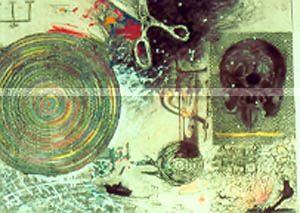|
Art Review
Trio teams to make collographs by committee
By Victoria Dalkey, Bee Art Correspondent, The Sacramento Bee
 |
"Snail's Pace" features a spiral, scissors and a screenline ptter of hexagonal shapes
|
| |
|
For sheer visual vitality, you can't beat b. sakata garo's current show of collaborations by three of California's best-known artists--William Wiley, Robert Hudson and Richard Shaw.
Wiley, 62, and Hudson, 61, have been friends since boyhood days in Richland, Wash., and toe two have known Shaw, 58, sicne the 1960s. What oculd be more fun that letting them loose in a print workshop? That's what Don Farnsworth of Magnolia Editions in Oakland did. The result is a rollicking series of richly textured collographs with mixed-media additions that have a cut-loose, ad-hoc spirit that makes them irresistible.
Collographs are prints in which proofs are pulled from blocks on which the design or patter is built up in the manner of a collage. A great variety of objects may be adhered to the block, which is inked, wiped to leave ink only in the depressions, and printed on an etching press. The technique lends itself to creating interesting effects of tone and texture, including deeply embossed ares. Adding to the collage-like effect, Wiley, Hudson and Shaw have added mixed-media elements, taking turns drawing, painting and gluing photographs and found objects to the prints.
A few of the pieces are really three-dimensional works. "Paint Box," which includes images of a Campbell's soup can and a studio still life, is torn away to reveal a reproduciton of a print from Francisco Jose de Goya's "Disasters of War." The thick torn section of paper that curls away from the surface of the print is pierced with a blue pencil.
"Vet," a savegly ironic protest against war, extends into three dimensions with a wire profile of a head waring a flag as a bandanna. And Shaw, in a solo piece, offers a printed image of a blue sea with a recessed space in which he has placed a freighter, made of trompe l'oeil ceramic money.
Wiley, who is known for wry narrative paintings and sculpture that critic Hilton Kramer once described as "Dude Ranch Dada," seems to be the guiding spirit behind many of the works. Punning titles abound, such as "China See" on a juicily textured image of ocean with a cutout image of ocean with a cutout image of a mandarin; and "Solid Tear," on an image of a window with decorative grille work with trompe l'oeil playing cards by Shaw. Other Wileyesque touches include cryptic texts, meandering lines and the appearance of whimsical characters such as Mr. Sillyhead.
"Etc.," a lampoon of the Free Willy rage, whose central image is a beached whale on a rocky shore; and "Homer," His Puppy and His Pappy," a delicate drawing of artist Winslow Homer with his father and his dog set in a window in a patterned dark blue sea, are pure Wiley. So are "Mr. Sillyhead on the Street," with its fey figure of a child in a top hat and elliptical narrative; and "Here Spy," an image of philospher-alchemists punctuated with arcane symbols.
It is more difficult to see Hudson's hand in the prints, though "Rescue" partakes of the vivid color and antic forms of his brightly painted, exuberant sculptures of the '60s, which Thomas Albright described as akin to "an explosion in a comic book factory." On the other hand, Shaw's sensibility is the focus of "Soup Can't," an image of his familiar stick-figure man made up of a soup can and teatpot with spindly legs.
ome of the most intriguing pieces in the show are ones in which no one artist dominates and the spirit of true collobration prevails. "Quarter Round" is a compelling image in which a deeply embossed sphere of concentric circles emerge from a tarry, black, viscous surface. Set into slits in the sphere are quarters that recall those charity donation cards that you see at supermarket checkout stands. Spirals, labyrinthlike patters and a pair of scissors opened to cut are other elements in this steely, ominous piece.
Scissors and spirals also appear in "Stretch," an image of an elongated monkey on all fours, and "Snail's Pace," which includes the concentric sphere, a screenlike patter of hexagonal shapes suggesting a hive, and the dark, robed figure of a cleric.
The show also includes a series of shoji screens that combine Asian calligraphy, brush paintings and patterns with imagery found in the prints.
|
